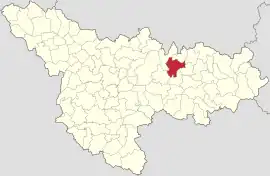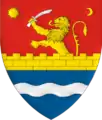Ghizela | |
|---|---|
 Location in Timiș County | |
 Ghizela Location in Romania | |
| Coordinates: 45°49′N 21°44′E / 45.817°N 21.733°E | |
| Country | Romania |
| County | Timiș |
| Established | 1880 |
| Government | |
| • Mayor (2020–2024) | Mircea Dinu Mirean[1] (PNL) |
| Area | 92.07 km2 (35.55 sq mi) |
| Population (2021-12-01)[3] | 1,113 |
| • Density | 12/km2 (31/sq mi) |
| Time zone | EET/EEST (UTC+2/+3) |
| Postal code | 307205–307208 |
| Vehicle reg. | TM |
| Website | www |
Ghizela (Hungarian: Gizellafalva; German: Giseladorf) is a commune in Timiș County, Romania. It is composed of four villages: Ghizela (commune seat), Hisiaș, Paniova and Șanovița.
History
Ghizela was founded by German colonists in 1880.[4][5] The journey they took to settle here was a longer one. They came from Giselahein (near Pančevo, in the Serbian Banat), where they had settled in 1868. But before that they had come from the village of Molydorf (near Zrenjanin, now disappeared), founded by the first German colonists in 1832. The first generation of colonists was from Alsace and Lorraine. The new settlement was located on a cleared land that belonged to Babșa and Șanovița.[4] The name was given after the village of Giselahein, where the German colonists had come from. In 1906 a second wave of colonization took place, this time with 45 Hungarian families. They formed a separate colony, and the Hungarian state built them a Catholic church in 1909.[4]
The first recorded mention of Hisiaș dates from 1410, when it is mentioned that it was part of the Duboz domain, together with four other localities. It may have disappeared completely during the Turkish period. The name Hiziasch, in the district of Făget, reappears on Count Mercy's map from 1723.[6] It was said that the inhabitants, Romanians, would have resettled here during the reign of Queen Marie, the Orthodox parish being established in 1770. In 1779 it was attached to Temes County and became the property of the Aerarium.
Paniova is first mentioned in Marsigli's notes from 1690 under the name Panjeva. After the conquest of Banat by the Austrians, at the first census made by the Habsburg authorities in 1717, the locality appears recorded with 20 houses, it is called Bangeva and belongs to the Făget District.[6] Until 1812 it was owned by the Aerarium, from which it was bought by the Demelich family. In 1896, colonizations were made with Roman Catholic Germans,[5] but in a smaller proportion than in other localities in Banat, the majority Romanian character remaining unchanged. However, the Germans formed an important community, reaching 40% by 1900.
According to historian Coriolan Suciu, the first recorded mention of Șanovița dates from 1359, in a document where it appears with the name of Sasanfalva ("Sasan's village").[7] Historian Nicolae Ilieșiu considers that the village dates back to the Turkish period. The Austrian census of 1717 records the village of Seschenovaz with 40 houses, belonging to the Făget District.[6] The inhabitants were mostly Romanians, but there were also Serbs, especially in the medieval past. In 1779 it was attached to Temes County and at the same time the Orthodox church was built.
Demographics
Ghizela had a population of 1,155 inhabitants at the 2011 census, down 11% from the 2002 census. Most inhabitants are Romanians (92.73%), with a minority of Hungarians (2.51%). For 3.2% of the population, ethnicity is unknown.[8] By religion, most inhabitants are Orthodox (89.7%), but there are also minorities of Roman Catholics (3.46%) and Baptists (1.99%). For 3.2% of the population, religious affiliation is unknown.[9]
| Census[10] | Ethnic composition | |||
|---|---|---|---|---|
| Year | Population | Romanians | Hungarians | Germans |
| 1880 | 2,205 | 2,105 | 20 | 48 |
| 1890 | 3,153 | 2,069 | 82 | 988 |
| 1900 | 4,106 | 2,202 | 68 | 1,810 |
| 1910 | 4,197 | 2,189 | 410 | 1,504 |
| 1920 | 3,715 | 1,961 | 363 | 1,348 |
| 1930 | 3,598 | 1,963 | 314 | 1,150 |
| 1941 | 3,638 | 1,970 | 312 | 1,066 |
| 1956 | 2,820 | 1,859 | 217 | 734 |
| 1966 | 2,505 | 1,829 | 199 | 461 |
| 1977 | 1,949 | 1,595 | 125 | 215 |
| 1992 | 1,311 | 1,223 | 54 | 22 |
| 2002 | 1,302 | 1,219 | 52 | 14 |
| 2011 | 1,155 | 1,071 | 29 | 6 |
References
- ↑ "Results of the 2020 local elections". Central Electoral Bureau. Retrieved 16 June 2021.
- ↑ "Primăria Ghizela". Ghidul Primăriilor.
- ↑ "Populaţia rezidentă după grupa de vârstă, pe județe și municipii, orașe, comune, la 1 decembrie 2021" (XLS). National Institute of Statistics.
- 1 2 3 Reiszig, Ede (1910). "Temes vármegye községei". In Borovszky, Samu (ed.). Magyarország vármegyéi és városai. Budapest: Országos Monografia Társaság.
- 1 2 Egler, Mathias (1990). Heimatbuch Giseladorf und Paniova.
- 1 2 3 Szabó, M. Attila (2003). Erdély, Bánság és Partium történeti és közigazgatási helységnévtára. Miercurea Ciuc: Pro-Print Kiadó.
- ↑ Suciu, Coriolan (1968). Dicționar istoric al localităților din Transilvania. Vol. II. Bucharest: Editura Academiei Republicii Socialiste România. p. 167.
- 1 2 "Tab8. Populația stabilă după etnie – județe, municipii, orașe, comune". Institutul Național de Statistică.
- 1 2 "Tab13. Populația stabilă după religie – județe, municipii, orașe, comune". Institutul Național de Statistică.
- ↑ Varga, E. Árpád. "Temes megye településeinek etnikai (anyanyelvi/nemzetiségi) adatai 1880-2002" (PDF).
